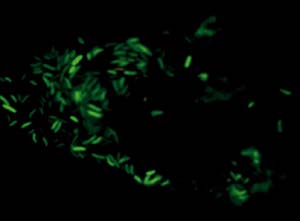| 2004 |

|
YEAR BOOK |
Institute of Technology Carlow
|
Development of whole-cell biosensors and microarray for use in bioremediation of environmental pollutants at IT Carlow
|

Whole-cell bacterial biosensors refer to intact, living microbial cells that have been genetically engineered to produce a measurable signal in response to a specific chemical or physical agent in their environment. These biosensors are cheap and reliable tools for the rapid measurement of the bioavailibility or bioremediation of target toxic compounds. They are engineered by paring specific promoters and reporter genes to generate signals through the switching on or off of the promoters by specific compounds. The selection of promoter is based on the target molecule to be monitored.
The reporters used include bioluminescence (lux) genes, colorimetric �-galactosidase (lacZ) activity or genes encoding for green fluorescent protein (GFP). The advantages of gfp markers are high resolution of single-cell detection and real-time in situ detection. A biosensor to detect the bioavailibility of 3-Chlorobenzoate (3-CBA) and the biodegradation of 3-Chlorobiphenyl (3-CBP) has been constructed by chromosomally inserting a xyl S-Pm- gfp mut3.1 construct into a genetically engineered PCB (polychlorinated biphenyl) degrading P. fluorescens strain at IT Carlow. This biosensor has been characterised and successfully applied to actual PCB contaminated environmental samples to detect 3-CBP biodegradation. The research group is planning to construct a series of promoter-reporter whole-cell endophyte (i.e. microorganisms that reside within plant tissue) biosensors to monitor the bioavailibility and bioremediation of toxic compounds in plants.
DNA microarray technology is a powerful functional tool that allows researchers to study gene expression and regulation on a genomic scale, and detect genetic polymorphisms in both eukaryotes and prokaryotes. DNA microarray is used in microbial ecology to detect and quantify different gene families involved in biogeochemical cycling, biodegradation, and pathogenesis in a high-throughput manner. Researchers at IT Carlow have designed a 50mer oligoarray containing thirty-five probes for detecting seventeen genes which are involved in the degradation of PCB, xylene, toluene, naphthalene, etc. It has been successfully shown to detect genes involved in these biodegrading pathways in pure culture. Future works include examining the ability of the oligoarray for the quantitative detection of genes in situ.
Contact: Xuemei Liu; Department of Science & Health, Institute of Technology Carlow.
E-mail: [email protected]